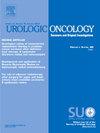IMPLEMENTATION OF A PATIENT-CENTERED MOBILE APPLICATION TO REDUCE COMPLICATION BURDEN AFTER CYSTECTOMY: A PILOT STUDY
IF 2.4
3区 医学
Q3 ONCOLOGY
Urologic Oncology-seminars and Original Investigations
Pub Date : 2025-03-01
DOI:10.1016/j.urolonc.2024.12.031
引用次数: 0
Abstract
Introduction
Radical cystectomy (RC) remains the mainstay of treatment for muscle invasive bladder cancer. RC carries high rates of morbidity and mortality, with readmission rates exceeding 25% within the first 90 days. Three quarters of these readmissions occur in the first 30 days following discharge, many of which are result from modifiable causes, such as dehydration and infection. These complications translate to worse patient outcomes, increased financial burden on patients and increased health care resource utilization. One method to identify and manage postoperative complications following discharge after RC is through enhanced post-operative patient monitoring and improved education. Mobile health presents an innovative and contemporary approach to tracking symptoms immediately following discharge. Our objective was to create and assess feasibility of an electronic medical record (EMR)-integrated platform to track post-operative symptoms for patients who underwent radical cystectomy.
Methods
A convenience sample of 15 patients who underwent robotic radical cystectomy by a single surgeon between August 2022-March 2024 at an academic medical center consented to participate. A cystectomy specific Care Companion (CC), an Epic© application that allows for push notifications and two-way communication between patients and providers, was created and integrated into the EMR. Following hospital discharge, patients received push notifications assessing post-operative symptoms, pain, nutritional intake, hydration, and activity. Abnormal responses prompted educational materials or generated clinical messages to the medical team, depending on severity. The frequency of push notifications decreased over time, but occurred at least daily until day 35. Concerning symptoms from the CC were automatically uploaded into the EMR, alerting all providers on the care team and promoting early follow-up.
Results
Patients were discharged from the hospital between 3-8 days postoperatively, with a median discharge day of POD4. Three patients experienced complications postoperatively, two of which required readmission. Readmission was due to bacteremia (n=1) and concurrent acute myeloid leukemia relapse (n=1).
11 of the 15 patients (73%) answered notifications at least once after discharge. Engagement with notifications was highest during the first 2 weeks after discharge, with 49% of patients responding to at least one notification daily, compared to 36% in weeks 3-5 (Figure 1). Two patients reported new symptoms through the triage questions, including new incision drainage and fever, both of which triggered provider alerts and follow-up. Of the two patients that were readmitted, one of the two patients used the care companion application regularly, responding 60% of days prior to readmission. Responses had high variability both between patients and within a single patient (Figure 2).
Conclusions
An EMR-integrated mobile application offered a streamlined approach to tracking convalescence after radical cystectomy, has the potential to identify complications and reduce readmissions. We identify that integration of this interactive technology into the EMR is feasible. This integration facilitated communication and minimized barriers of patients’ access to the urology care team. Patient engagement was highest during the first two weeks of discharge, and decreased thereafter, with relatively consistent use through day 35. Patient response included a variety of information pertaining to convalescence that may serve as early indicators of a developing complication. Concerning symptoms prompted follow-up with providers, allowing providers to evaluate patients sooner. Responses had high variability both between patients and within a single patient demonstrating value in tracking patient reported outcomes over time.
实施以患者为中心的移动应用程序,以减少膀胱切除术后的并发症负担:一项试点研究
根治性膀胱切除术(RC)仍然是治疗肌浸润性膀胱癌的主要方法。RC的发病率和死亡率都很高,在头90天内再入院率超过25%。其中四分之三的再入院发生在出院后的前30天,其中许多是由可改变的原因造成的,如脱水和感染。这些并发症导致患者预后恶化,患者经济负担加重,卫生保健资源利用率提高。识别和处理RC术后出院并发症的一种方法是通过加强术后患者监测和改进教育。移动医疗提出了一种创新和现代的方法,可以在出院后立即跟踪症状。我们的目的是创建并评估电子病历(EMR)集成平台的可行性,以跟踪接受根治性膀胱切除术患者的术后症状。方法选取同意参与研究的15例于2022年8月至2024年3月在某学术医疗中心接受机器人根治性膀胱切除术的患者作为方便样本。一个膀胱切除术特定护理伴侣(CC),一个Epic©应用程序,允许推送通知和患者和提供者之间的双向通信,被创建并集成到EMR中。出院后,患者收到评估术后症状、疼痛、营养摄入、水合作用和活动的推送通知。根据严重程度的不同,异常反应会给医疗团队提供教育材料或生成临床信息。随着时间的推移,推送通知的频率逐渐降低,但在第35天之前至少每天都会出现。CC的相关症状被自动上传到电子病历中,提醒护理团队的所有提供者并促进早期随访。结果患者均于术后3 ~ 8天出院,中位出院日为4天。3例患者术后出现并发症,其中2例需要再次入院。再入院是由于菌血症(n=1)和并发急性髓性白血病复发(n=1)。15例患者中有11例(73%)出院后至少回复了一次通知。在出院后的前两周,患者对通知的参与度最高,49%的患者每天至少回应一次通知,而在第3-5周,这一比例为36%(图1)。两名患者通过分诊问题报告了新的症状,包括新的切口引流和发烧,这两种情况都触发了医生的警报和随访。在再次入院的两名患者中,其中一名患者定期使用护理伴应用程序,在再次入院前应答60%。结论emr集成移动应用程序提供了一种简化的方法来跟踪根治性膀胱切除术后的康复情况,具有识别并发症和减少再入院的潜力。我们认为将这种交互技术集成到电子病历中是可行的。这种整合促进了沟通,并最大限度地减少了患者进入泌尿外科护理团队的障碍。在出院的前两周,患者的参与度最高,此后下降,直到第35天使用相对一致。患者反应包括与康复有关的各种信息,可作为发展中并发症的早期指标。对症状的关注促使医护人员对患者进行随访,使医护人员能够更快地对患者进行评估。反应在患者之间和单个患者内都具有很高的可变性,这表明随着时间的推移跟踪患者报告的结果具有价值。
本文章由计算机程序翻译,如有差异,请以英文原文为准。
求助全文
约1分钟内获得全文
求助全文
来源期刊
CiteScore
4.80
自引率
3.70%
发文量
297
审稿时长
7.6 weeks
期刊介绍:
Urologic Oncology: Seminars and Original Investigations is the official journal of the Society of Urologic Oncology. The journal publishes practical, timely, and relevant clinical and basic science research articles which address any aspect of urologic oncology. Each issue comprises original research, news and topics, survey articles providing short commentaries on other important articles in the urologic oncology literature, and reviews including an in-depth Seminar examining a specific clinical dilemma. The journal periodically publishes supplement issues devoted to areas of current interest to the urologic oncology community. Articles published are of interest to researchers and the clinicians involved in the practice of urologic oncology including urologists, oncologists, and radiologists.

 求助内容:
求助内容: 应助结果提醒方式:
应助结果提醒方式:


